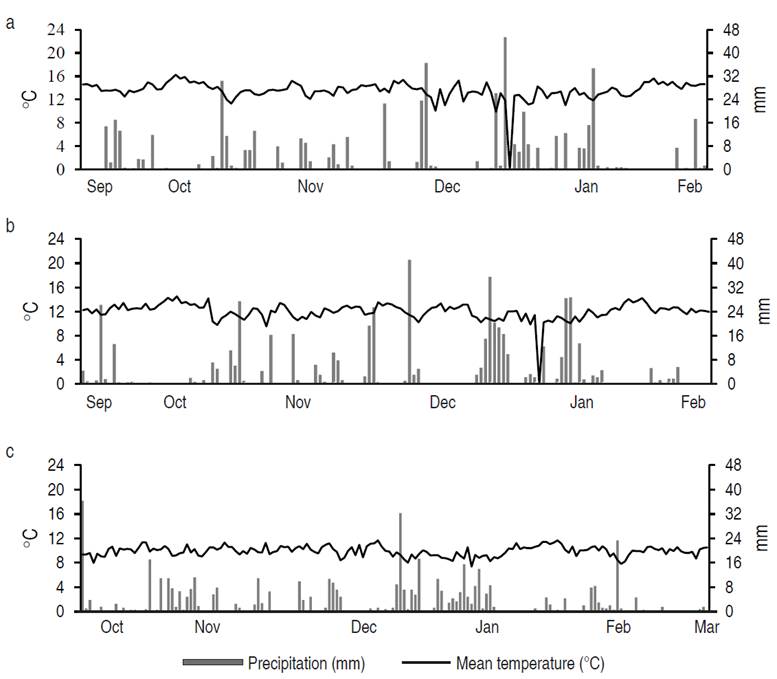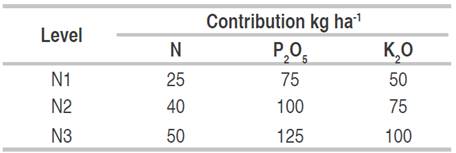Potato, along with wheat, rice, and maize are of great global importance as a food source, due to their nutritional and medicinal value (Arcos and Zúñiga, 2016). In Solanum tuberosum, the Tuberosum and Andigena groups are the most important, by area planted and production volume, and the Phureja group, to which the so-called creole potatoes belong, is of special relevance in Colombia due to its acceptance among consumers, for its good taste, nutritional quality, agro-industrial suitability, lower costs and production cycles (Molina-Cita et al., 2015).
In Colombia, potato is grown in high areas of the three mountain ranges, 90% corresponds to the Andigena group and the remaining 10% to the Phureja group (Fedepapa, 2017). Of the Andigena group, few cultivars have productive cycles of less than 5 months; Morasurco is one of them, which the farmer relates to the Phureja group because of the length of the cycle, the growing conditions and its management in the field, and post-harvest (Moreno, 2000). It is also a cultivar little described in the literature. Colombia is the main producer worldwide of Morasurco. In addition, it is the food base of peasant communities, especially in the South of the country, where it is considered its origin (Ñústez, 2018).
The development of the crop has a wide variability of production conditions, which depend on environmental heterogeneity. Thus, the agronomic management activities obey the specific behavior of the cultivars and their interaction with the environments and systems. One of the main parameters that defines the type of activities in the cultivars corresponds to the tuber production cycles; these can be defined as early, medium, or late tuberization (Moreno, 2000).
For potato production in Colombia, regardless of the group or cultivar used, fertilization is one of the items with the highest share in production costs (approximately 20%). This practice is generally carried out based on empirical knowledge and in the absence of soil analysis. However, studies conducted by Bautista et al. (2012), on nutrient absorption in the Criolla Colombia variety, indicate that the elements N, P, K, Ca, Mg, Zn, B, and S are the most important and with the highest absorption up to 113 days after planting (DAP). Likewise, Torres and Suarez (2014) did not find differences in absorption levels after 77 DAP, when evaluating commercial doses in short cycle genotypes. Muñoz and Lucero (2008) found higher yields for commercial varieties when they added between 800 and 1200 kg ha-1 of organic matter and 300 kg ha-1 of 13-26-6 (NPK -nitrogen-phosphorus-potassium).
In addition to the nutritional component, factors such as environment and cultivar and their interaction determine yield capacity. Yield studies of the Phureja group vary significantly when contrasting traditional cultivars with commercial varieties. For example, yields from 6.2 to 27 t ha-1 have been reported for the former (Gómez-García, 2017) and for the latter up to 41.8 t ha-1 (Santos, 2010; Bautista et al., 2012). Silva et al. (2017) evidenced effects on physiological parameters in creole potato with variation in doses of potassium fertilizers and different sowing densities, works that suggest variability in the responses associated with the interaction of environmental, nutritional, and genetic factors. Therefore, it is convenient to study fertilization on cultivars, in addition to nutrient doses, management systems, and interaction with particular soil and climatic conditions.
Marcillo et al. (2021) and Benavides et al. (2021) compiled relevant information and research results regarding potato cultivation in the department of Nariño, Colombia. In this sense, it is highlighted the definition of four zones or homogeneous environments with particular edaphoclimatic characteristics. These have among them differences in the mineral composition of the soils, management practices and socio-cultural aspects, which imply diversity of responses of the genotypes identified as predominant in the potato zone of the department.
Based on the above considerations, this study aimed to evaluate the response of four short-cycle potato cultivars (three genotypes of S. tuberosum Phureja group and one of S. tuberosum Andigena group) to differential fertilization levels and soil and climatic conditions.
MATERIALS AND METHODS
Location
The study was carried out in the South of the department of Nariño - Colombia, with evaluations in three of the four homogeneous environments characterized by Marcillo et al. (2021), for the potato-producing area (AH1, AH2 and AH4, respectively), which have particular edaphoclimatic characteristics of altitude, precipitation, temperature, slope, texture and soil pH (Table 1). The experimental plots were located in farmers' properties in the municipalities of Guaitarilla, Providencia and Guachucal, respectively. The climatic conditions in each environment evaluated were: in Guaitarilla (AH1) an accumulated rainfall of 543.9 mm, distributed throughout the crop cycle and an average daily temperature (ADT) of 13.7 °C (Figure 1a); in Providencia (AH2) an accumulated rainfall of 534.8 mm, with little rainfall at the beginning and end of the crop and an ADT of 12.1 °C (Figure 1b), lower than the historical range and, in Guachucal (AH3), accumulated precipitation of 479.4 mm, with low rainfall regimes at the end of the crop and an ADT of 9.9 °C (Figure 1c).
Table 1 Edaphoclimatic characteristics of three homogeneous production environments of S. tuberosum Phureja and Andigena groups in Nariño-Colombia and location of experimental plots.
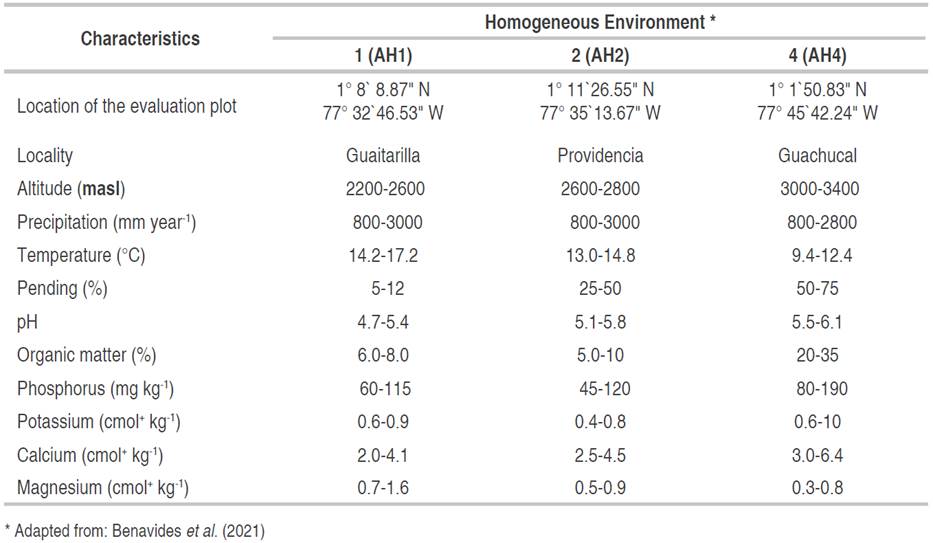
Plant Material
The traditional cultivars Mambera and Ratona Morada and the varieties Criolla Colombia and Morasurco were evaluated. These were classified as the most frequently cultivated, in the short-cycle group, based on the characterization of the production system in Nariño (Benavides et al., 2021). Mambera has a semi-extended growth habit, green stems, round tubers with deep eyes and red skin with cream spots. On the other hand, the growth habit of Ratona Morada is semi-erect, pigmented stem, purple-skinned tuber and white pulp (Tinjacá and Rodriguez, 2015). Criolla Colombia shows semi-erect plants, with thin stems and round tubers with yellow pulp and skin (Moreno, 2000). Morasurco has erect plants, thick dark green stems, flattened round tubers, purple skin with cream spots and cream-colored pulp, and has a similar crop cycle to Criolla Colombia, Mambera and Ratona Morada, which is why it was included in this study.
Experimental design
An experiment was established in each environment under a randomized complete block design with a split-plot arrangement and three replications. The main plot included three fertilization levels based on input from average soil analyses for the area and requirements of commercial varieties (Table 2) and the subplot included the four cultivars mentioned above. The experiments were established considering a planting density of 33.333 plants ha-1. Each experimental plot occupied an area of 42 m2, of which 25 m2 were used for the evaluations.
Agronomic and physiological variables
Variables evaluated were selected according to the yield parameters. Destructive sampling was done every two weeks, from emergence to harvest, for a total of 24 plants per treatment; the samples were taken to an oven, Memmert brand, and kept at 70 °C until constant dry weight. With the information obtained, the accumulation of dry matter of the plant until the harvest was calculated. In addition, the leaf area was determined and in the field the soil area covered by the foliage, to estimate along with the above information: leaf area index (LAI), net assimilation rate (NAR), crop growth rate (CGR), and relative growth rate (RGR), according to methodologies adapted from Pandey et al. (2017). Harvest index (HI) was calculated as the ratio of tuber dry matter to that of the total plant, according to Mohamed et al. (2017).
In each experimental unit, in addition to the total yield, the number, size, and weight of tubers were recorded. A tuber size scale was generated for the cultivars of the Phureja group, according to the commercial classification in the area (Table 3). For Morasurco, the Colombian Technical Standard NTC 341 (ICONTEC, 1996) was used. The results of tubers of size zero and first in a single group were considered because they represent a higher commercial value.
Statistical analysis
Analysis of variance (ANOVA) was performed for each yield component and comparison of means with Tukey’s test (P=0.05). Models were generated to explain dry matter accumulation by cultivar, in each evaluated environment. Discriminant analysis of principal components (DAPC) was performed with yield variables and physiological indices. This is a multivariate method to identify and describe groups of related individuals, which allows visual assessment of the differentiation between groups. The packages ExpDes (Ferreira et al., 2013), Adegenet (Jombart, 2008) were used in the statistical program R, version 4.0.3. (R Core Team, 2020).
RESULTS AND DISCUSSION
Performance Components
In environment AH1 the highest yield was reached by Morasurco (38.5 t ha-1) and the lowest by Ratona Morada (19.4 t ha-1). The yield of tubers of greater commercial value (size zero and first) of Criolla Colombia was 18.7 t ha-1, which represents 80% of its total yield, contrasting with 24.0 t ha-1 in Morasurco, corresponding to 62%. In the number of tubers per plant, Criolla Colombia presented the highest value (24.5), while at the other extreme, Mambera and Ratona Morada presented 13.2 and 12.8, respectively. The HI for this environment ranged between 0.40 and 0.71, with statistical differences between Criolla Colombia (0.40) and the other cultivars.
In the AH2 environment, the averages were below those obtained in AH1. However, the cultivars benefited with the highest fertilization level (N3), increasing the yield by about 7 t ha-1 with respect to the averages reached with the other two levels (Table 4). There was no interaction effect between levels and cultivars, but there were differences between cultivars for the variables yield, number of tubers per plant and HI. For these variables, Morasurco presented the highest values, while Criolla Colombia, Mambera and Ratona Morada presented similar values between them, but lower than those observed in AH1.
Table 4 Average yield components for four short-cycle potato cultivars in three environments in the department of Nariño.
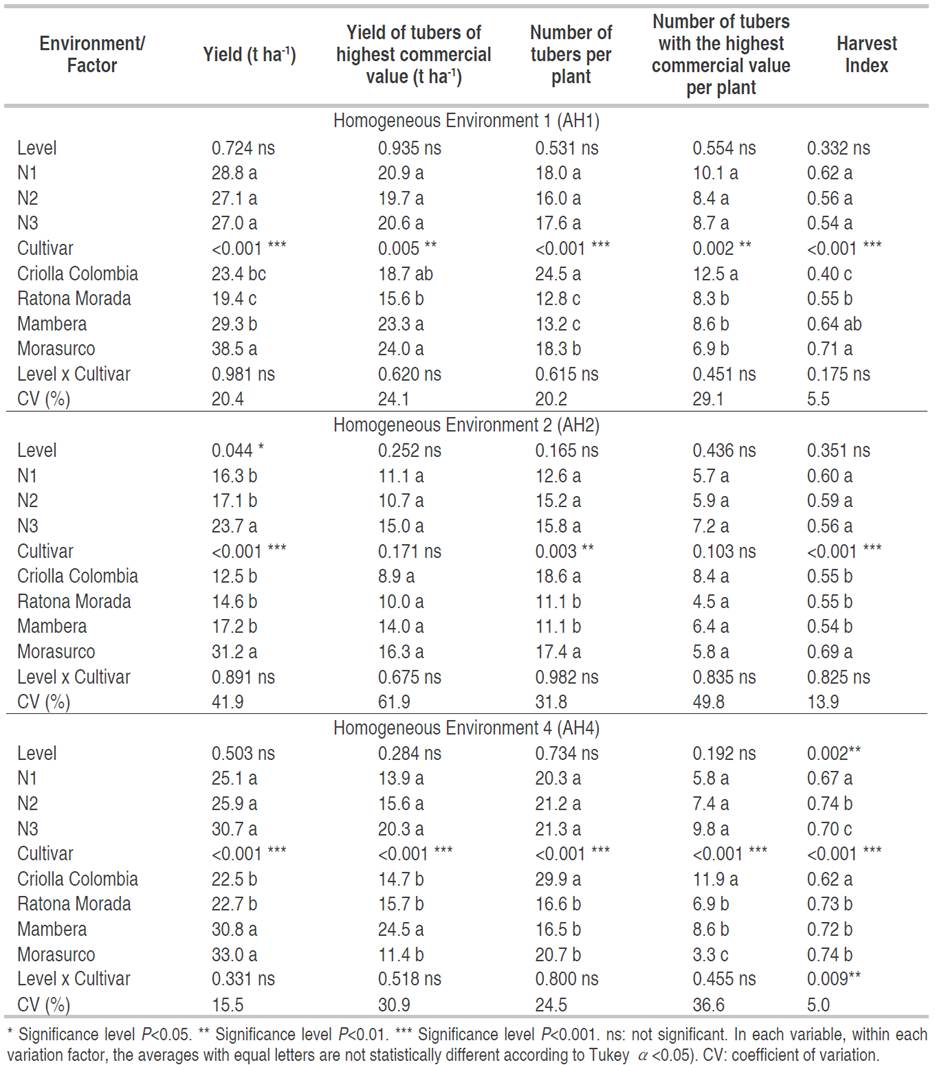
Although AH4 produced 5 t ha-1 more at the N3 level than N1 and N2, there were no statistical differences (Table 4). Fertilization levels also did not affect the number of tubers per plant, but the HI was higher than those observed in the other environments. In this environment there were differences for cultivars in yield and number of tubers per plant; the genotypes with the highest yield were Morasurco (33.0 t ha-1) and Mambera (30.8 t ha-1). In the case of the number of tubers per plant and number of tubers of higher commercial value per plant stood out was Criolla Colombia.
In the evaluation of fertilization levels in S. tuberosum, Sifuentes et al. (2013) did not find differences in the extraction rates, but in the absorption levels. They inferred that this result is due to genetic and environmental factors, which determine the differential extraction between cultivars. This agrees with the results of the present work since differences were observed between genotypes within the environments, but it was not conclusive between the fertilization levels evaluated.
In Colombia, the importance of minor elements in potato fertilization is underestimated, since their application is not considered, although in the soil there are low levels of nutrients (Gómez et al., 2006). According to Marcillo et al. (2021), magnesium is one of the elements that presents lower concentrations in soils of the producing zone of the department of Nariño, being this element a possible influential factor on the productivity of the crop. Considering the above, the fact that no differences were found between NPK fertilization levels in the evaluated cultivars, could indicate that the yield improvement for these cultivars may be conditioned to other elements of low availability.
Besides yield, it is important to analyze quantitative variables and yield components, as a base for the estimation of parameters to intervene in the agronomic management of the crop (Hay and Walker, 1989). The behavior of the yield components in the cultivars was different in each environment, especially in the Criolla Colombia variety, which constitutes an advantage that can be used in the response and specific yield. It would be valid to propose particular practices between environments within cultivars and to identify productive alternatives by region (Huerta-Fernández et al., 2021).
Regarding HI results, the interaction level by cultivar was only significant in AH4 (Table 4; Figure 2); level N2 obtained higher HI for Criolla Colombia and Mambera, while N3 for Morasurco. Under harvest stages similar to those of the present study (senescent plant), Santos (2010) obtained values in Phureja genotypes from 67 to 73% at 2859 masl and from 51 to 66% at 2572 masl, ranges similar to those found in the present work.
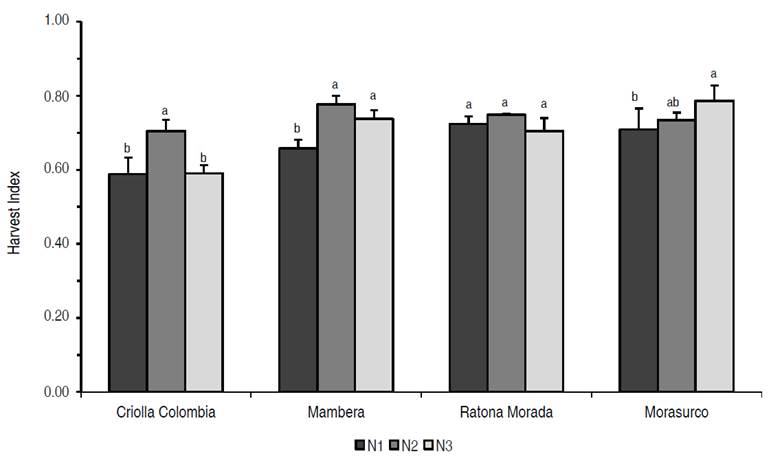
Figure 2 Harvest index in response to three levels of fertilization for four potato cultivars, in homogeneous environment 4 (AH4: Guachucal-Nariño locality). Within each cultivar, means with equal letters are not statistically different (P<0.05).
For varieties of S. tuberosum of the Andigena group, Ñústez et al. (2009) found HI of 71 to 85%, coinciding with the behavior of the Morasurco variety in this study, which obtained in all environments the highest value (between 69 and 74%). The same authors suggest that parameters such as HI are essential in yield since it can be improved by agronomic practices that lead to a greater allocation of dry matter to the tubers.
Dry Matter Accumulation and Physiological Indices
In the three environments, dry matter accumulation of all cultivars was adjusted to a quadratic model (Figure 3 a-c), with highly significant adjustments (R2=0.97; P<0.01). In AH1 and AH2 the length of the growing season was similar, but dry matter accumulation was lower in AH2. At the end of the cycle, the cultivar with the lowest dry matter accumulation in AH1 was Criolla Colombia (176.9 g plant-1), followed by Mambera (250.5 g plant-1) and Ratona Morada (288.5 g plant-1) and the highest accumulation was in Morasurco with 350.2 g plant-1 (Figure 3a), and a cycle 15 days longer than the other three. For environments AH2 and AH4, dry matter accumulation was in the same order, with lower values for Criolla Colombia, followed by Mambera, Ratona Morada, and Morasurco, with 133.3 g plant-1, 161.8 g plant-1, 186.6 g plant-1 and 278.7 g plant-1 in AH2 (Figure 3b) and 218.9 g plant-1, 213.9 g plant-1, 272.7 g plant-1 and 302.8 g plant-1 in AH4 (Figure 3c), respectively.
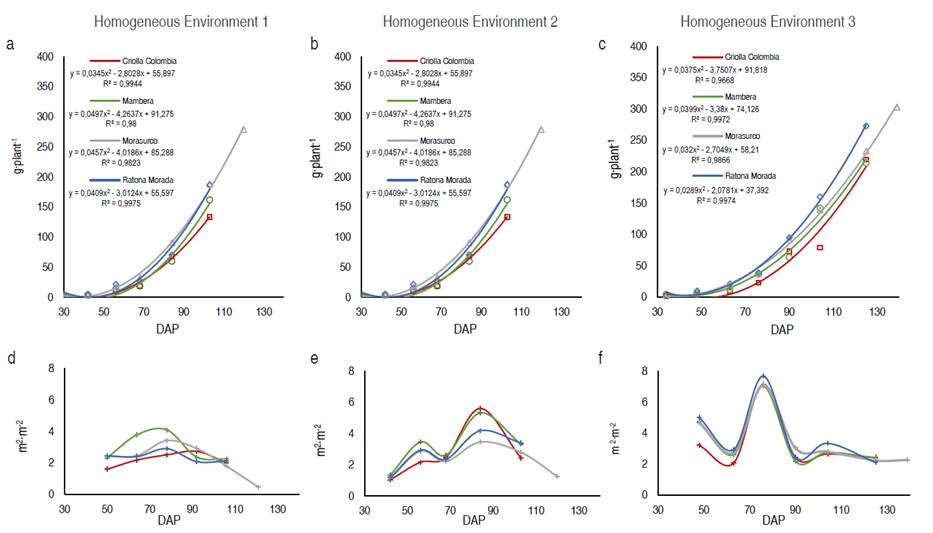
Figure 3 Average accumulated dry matter (a, b, c) and leaf area index (d, e, f) of four potato genotypes in three environments. DAP: days after planting.
The dry matter content of a plant is related to the efficiency of the foliage to intercept and use solar radiation during its productive cycle. Besides being a genetically controlled trait, it is affected by genotype-by-environment interaction and management practices (Hay and Walker, 1989). This aspect was especially observed in AH4, where the accumulation was slower, consistent with what was expected in the environment of higher altitude and lower average temperature.
Saldaña-Villota and Cotes-Torres (2020) evaluated this variable in three potato cultivars of the Phureja group at 2575 masl and found that regardless of the fertilization level used, the highest accumulation occurred in the same phenological stage, with a similar behavior among genotypes and values around 220 g plant-1. These values were higher than those found in the present work, even for Morasurco (Andigena), which, despite having an early tuberization cycle (Moreno, 2000), has a different architecture and leaf mass than the Phureja group. This result is possibly related to the climatic conditions during the evaluation, which was a relatively dry period (below requirements) in all environments.
Regarding the Leaf Area Index (LAI) in the AH1 environment, the highest values found were 4.1, 3.4, and 2.9 m2 m-2 at 78 DAP for Mambera, Morasurco and Ratona Morada, respectively (Figure 3d), while for Criolla Colombia, it occurred at 92 DAP with 2.7 m2 m-2. In AH2, the LAI presented peaks at 56 and 84 DAP, for the four cultivars (Figure 3e), the latter being more pronounced. Ratona Morada showed the highest index (4.2 m2 m-2), while the lowest value was for Morasurco (3.5 m2 m-2). In AH4 there were also two defined peaks for LAI values, in the four cultivars: the first one close to 48 DAP and the second one at 76 DAP. The highest index value occurred in Ratona Morada (7.7 m2 m-2), although the other three cultivars presented similar values (Figure 3f).
The LAI obtained its highest value in the tuberization phase and decreased from that moment until harvest. This behavior was also observed by Saldaña-Villota and Cotes-Torres (2020), in the evaluation of Phureja cultivars with different fertilization levels, which also agrees with the observations made by Santos-Castellanos et al. (2010). A decrease in the LAI value prior to the maximum peak was also observed, especially in AH2 and AH4, behavior that is the result of agronomic practices or by translocation of assimilates that cause leaf abscission at the end of the cycle, that affect the components of the index (Montoya et al., 2016). On the other hand, the differences in altitude between the evaluated environments, which would suppose a higher thermal utilization index in lower altitudes or with less accumulated thermal time (Lizarazo, 2020), for the present study the time to tuberization was similar between environments, both for the cultivars of the Phureja group and for the Andigena group, due to lower precipitation in AH4.
The values obtained for the Net Assimilation Rate (NAR) were below 0.1 g dm-2 day-1. The maximum values were reached near 60 DAP for all cultivars in AH1 and AH2, while in AH4 they had a differential behavior among cultivars (Figure 4). This index is an indicator of photosynthetic efficiency, which relates the dry matter produced to the leaf area present during a given period of plant growth.
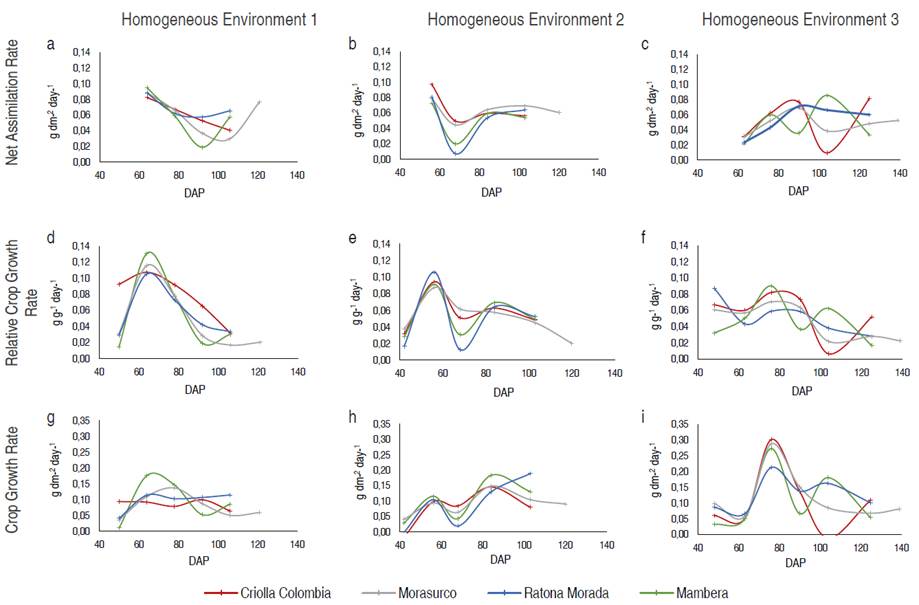
Figure 4 Growth rates in four short cycle potato genotypes in three environments: Net Assimilation Rate (a, b, c); Relative Crop Growth Rate (d, e, f); Crop Growth Rate (g, h, i). DAP: days after planting.
In AH1 all cultivars presented the highest NAR value at 64 DAP (0.095 g dm-2 day-1), then it decreased gradually, with a slight increase in the last period evaluated, except in Criolla Colombia, whose values decreased until the end of the period. The cultivars Criolla Colombia and Ratona Morada decreased in smaller proportion with respect to Mambera and Morasurco, which decreased to 0.019 and 0.029 g dm-2 day-1, respectively. In AH2, the maximum values was presented at 56 DAP, followed by the lowest rates at 68 DAP for all cultivars. In this environment, Criolla Colombia and Morasurco were the cultivars with less extreme variations, unlike Mambera and Ratona Morada, in which the NAR dropped to 0.020 and 0.007 g dm-2 day-1, respectively (Figures 4a and 4b).
The NAR for AH4 presented a diverse behavior in each cultivar. Morasurco and Ratona Morada presented the highest value at 90 DAP (0.069 and 0.071 g dm-2 day-1 respectively). In Mambera the maximum NAR was presented at 104 DAP (0.086 g dm-2 day-1) and its lowest value at 125 DAP, inverse behavior to that of Criolla Colombia, which presented at 104 DAP with the lowest rate (0.009 g dm-2 day-1) and at 125 DAP the highest value (0.082 g dm-2 day-1) (Figure 4c).
The CGR was particular in each environment, in AH1 the maximum value was found in one growth stage, in AH2 two stages, and in AH4 there was not a predominant behavior (Figure 4). In AH1 the highest values obtained were 0.10-0.13 g g-1 day-1, at 64 DAP for all cultivars (Figure 4d). From this point, Criolla Colombia was the most efficient since it maintained higher values during the rest of the crop cycle. On the other hand, in AH2, Morasurco had only one maximum stage, in contrast to the other cultivars, which presented the first stage at 56 DAP and the second at 84 DAP (Figure 4e). In the case of AH4, the relative growth rates were lower than 0.09 g g-1 day-1. In the latter, the values for Mambera, Morasurco and Ratona Morada were not lower than 0.02 g g-1 day-1 in the whole cycle (Figure 4f), unlike what was presented in the first two environments, where the CGRs went down to 0.01 g g-1 day-1. These results coincide with those reported by Santos (2010), who observed the highest values in the early stages of the crop cycle. In the case of Criolla Colombia, they agree that the minimum values of NAR were concordant with the minimum values of RGR under the influence of the low level of fertilization.
Similarly, in AH1, the highest value of CGR expressed as weight gain per unit area and time, occurred at different times in each cultivar and environment: for Mambera at 64 DAP (0.18 g dm-2 day-1), Morasurco at 78 DAP (0.14 g dm-2 day-1), Criolla Colombia 92 DAP (0.10 g dm-2 day-1) and Ratona Morada at 106 DAP (0.12 g dm-2 day-1). The last two presented the most stable growth throughout the cycle (Figure 4g). The CGR in AH2, in agreement with the RGR, presented two periods of increase in the rate, the first at 56 DAP and the second later at 84 DAP (Figure 4h). The four cultivars presented the highest growth rates in AH4, at 76 DAP, where 0.301 g dm-2 day-1 was registered in Criolla Colombia, 0.273 g dm-2 day-1 in Mambera, 0.287 g dm-2 day-1 in Morasurco and 0.213 g dm-2 day-1 in Ratona Morada. A second stage occurred in Ratona Morada and Mambera at 104 DAP (Figure 4i).
In contrast to this work, Saldaña-Villota and Cotes-Torres (2020) evidenced differences in growth through physiological parameters, as a response to various levels of fertilization. These authors observed higher growth in the Criolla Latina variety with the highest dose, while in the Guaneña variety with a lower dose, indicating different levels of earliness. However, similar to this study, there was a decrease in growth rates at the end of the cycle. Santos (2010) evaluated genotypes of Phureja in differential environmental conditions, who also observed the increase of growth rates until around the middle of the productive cycle, and then decrease until the end.
The behavior for the parameters NAR, RGR, and CGR, was predictable in terms of the altitudinal differential of the locations evaluated, showing the highest values in the highest environments. Therefore, these parameters should be analyzed at the cultivar level in each environment.
Discriminant analysis of principal components.
In the analysis of the physiological and yield variables, including information from the three environments, were summarized in the first two principal components of DAPC (Figure 5). The cultivars showed a response pattern where the Morasurco cultivar differs from the genotypes of the Phureja group and among these Criolla Colombia separates from Ratona Morada and Mambera that, according to the evaluated variables, have a similar behavior. The variables that had the greatest influence were HI, NAR, RGR, and CGR.
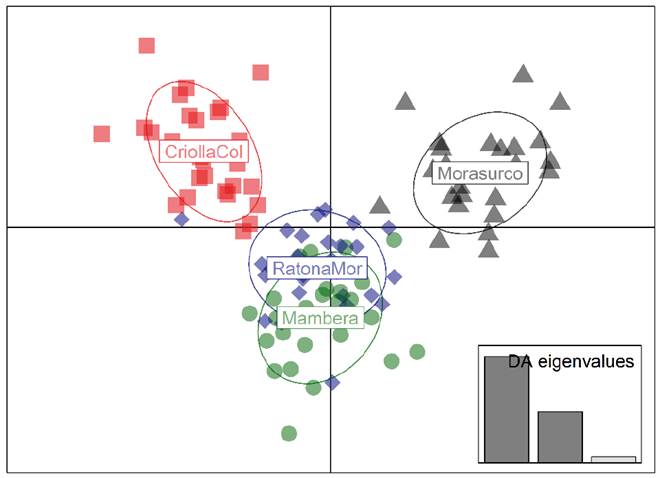
Figure 5 Biplot of DAPC of four short-cycle potato cultivars. The dispersion in the first two principal components is plotted, using the cultivars as a priori groups. The ellipses of inertia are subscribed according to the experimental units of the cultivars, in the three homogeneous environments evaluated, represented with squares for Criolla Colombia, diamonds for Ratona Morada, circles for Mambera and triangles for Morasurco.
This result agrees with the differences captured in the analysis of variance between cultivars, within each environment (Table 4), which can be attributed to their genetic variability. This aspect was also considered by Huerta-Fernández et al. (2021), who attributed these differences to the genetic factor when they evaluated the yield of genotypes of the Phureja group in differential environments over time.
Two main groups can be found in the biodiversity of cultivated potatoes. The first group includes the so-called traditional or native varieties, which are the result of a process of domestication, selection, and ancestral conservation, and are generally associated with marginal production zones in high altitude or moorland areas. In the second are located the varieties that result from a process of genetic improvement; these possess attributes in terms of yield potential, resistance to phytopathogens, and organoleptic characteristics, among others (Monteros and Reinoso, 2010). The results evidenced in the present study agree with this classification. The genetic variability is represented initially by the Andigena group, with the variety Morasurco, coming from genetic improvement, while in the Phureja group the variety Criolla Colombia is a variety improved by clonal selection, which is separated from Ratona Morada and Mambera, which are traditional or native cultivars (Figure 5).
On the other hand, the conformation of homogeneous environments based on altitude, climatic information, relief, and soils (Marcillo et al., 2021), generated differential responses in the cultivars. The physiological variables NAR, RGR, and LAI had the greatest influence on the discrimination of environments in the DAPC (Figure 6).
The research of potato cultivars in different environments has been mainly focused on the genetic factor, caused in part by the processes of domestication, cultural exchange, and native or improved varieties that, according to the area where it is produced, acquire management plans associated with edaphoclimatic requirements, without considering fundamental aspects that can differentiate them. The choice of experimental plots in the present study was due to an adequate selection of environmental diversity for the producing area, ratifying the importance of the evaluation of practices or management systems of cultivars, which sometimes could be more efficient in specific areas.
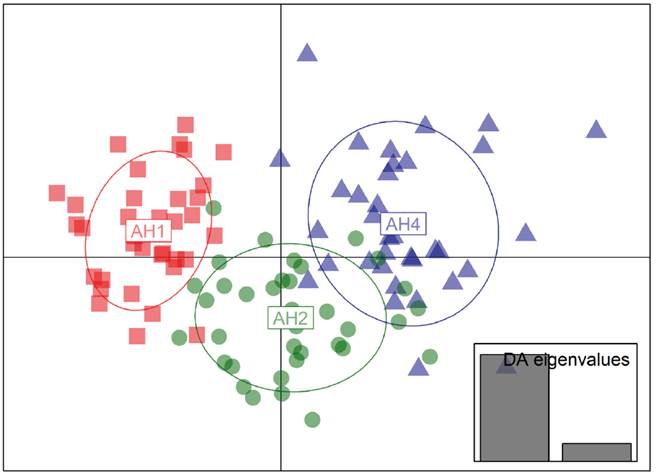
Figure 6 Biplot of DAPC of short-cycle potato cultivars in three homogeneous environments (AH). The dispersion of four cultivars in the first two principal components of the DAPC is plotted, using the homogeneous environments as a priori groups. The inertia ellipses underwrite the experimental units of the cultivars, which for AH1 are represented by squares, for AH2 by circles and for AH4 by triangles.
CONCLUSIONS
Considering yield and DAPC, differences in behavior were observed for the Morasurco cultivar with respect to the Phureja cultivars and within this group Criolla Colombia differed from the other two. The productivity of the evaluated cultivars was mainly influenced by the environments. Ratona Morada and Mambera are alternatives for high zones because they presented higher yield in AH4, an aspect possibly associated with its traditional character, which suggests better adaptation in high zones and, on the contrary, Criolla Colombia when evidencing better yield in AH1 and AH2 indicates its adaptation with respect to zones of higher altitude. Morasurco presented a similar behavior in the three environments, indicating wide adaptability of the cultivar in different productive conditions.
Except for the AH2 environment, for the variable yield per hectare, and AH3 for HI, the fertilization levels evaluated did not present statistical differences. This behavior was observed in the yield components as well as in the physiological parameters. Possibly the nutritional requirements of the evaluated genotypes are limited by elements different from those evaluated and it is required to deepen the evaluation of sources or levels related to secondary and minor elements that allow improving the productivity.














